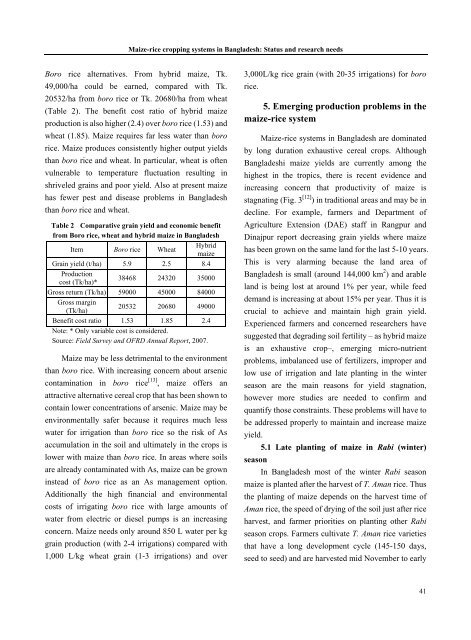Maize-rice cropping systems in Bangladesh - Search CIMMYT ...
Maize-rice cropping systems in Bangladesh - Search CIMMYT ...
Maize-rice cropping systems in Bangladesh - Search CIMMYT ...
Create successful ePaper yourself
Turn your PDF publications into a flip-book with our unique Google optimized e-Paper software.
<strong>Maize</strong>-<strong>rice</strong> <strong>cropp<strong>in</strong>g</strong> <strong>systems</strong> <strong>in</strong> <strong>Bangladesh</strong>: Status and research needsBoro <strong>rice</strong> alternatives. From hybrid maize, Tk.49,000/ha could be earned, compared with Tk.20532/ha from boro <strong>rice</strong> or Tk. 20680/ha from wheat(Table 2). The benefit cost ratio of hybrid maizeproduction is also higher (2.4) over boro <strong>rice</strong> (1.53) andwheat (1.85). <strong>Maize</strong> requires far less water than boro<strong>rice</strong>. <strong>Maize</strong> produces consistently higher output yieldsthan boro <strong>rice</strong> and wheat. In particular, wheat is oftenvulnerable to temperature fluctuation result<strong>in</strong>g <strong>in</strong>shriveled gra<strong>in</strong>s and poor yield. Also at present maizehas fewer pest and disease problems <strong>in</strong> <strong>Bangladesh</strong>than boro <strong>rice</strong> and wheat.Table 2 Comparative gra<strong>in</strong> yield and economic benefitfrom Boro <strong>rice</strong>, wheat and hybrid maize <strong>in</strong> <strong>Bangladesh</strong>Item Boro <strong>rice</strong> WheatHybridmaizeGra<strong>in</strong> yield (t/ha) 5.9 2.5 8.4Productioncost (Tk/ha)*38468 24320 35000Gross return (Tk/ha) 59000 45000 84000Gross marg<strong>in</strong>(Tk/ha)20532 20680 49000Benefit cost ratio 1.53 1.85 2.4Note: * Only variable cost is considered.Source: Field Survey and OFRD Annual Report, 2007.<strong>Maize</strong> may be less detrimental to the environmentthan boro <strong>rice</strong>. With <strong>in</strong>creas<strong>in</strong>g concern about arseniccontam<strong>in</strong>ation <strong>in</strong> boro <strong>rice</strong> [13] , maize offers anattractive alternative cereal crop that has been shown toconta<strong>in</strong> lower concentrations of arsenic. <strong>Maize</strong> may beenvironmentally safer because it requires much lesswater for irrigation than boro <strong>rice</strong> so the risk of Asaccumulation <strong>in</strong> the soil and ultimately <strong>in</strong> the crops islower with maize than boro <strong>rice</strong>. In areas where soilsare already contam<strong>in</strong>ated with As, maize can be grown<strong>in</strong>stead of boro <strong>rice</strong> as an As management option.Additionally the high f<strong>in</strong>ancial and environmentalcosts of irrigat<strong>in</strong>g boro <strong>rice</strong> with large amounts ofwater from electric or diesel pumps is an <strong>in</strong>creas<strong>in</strong>gconcern. <strong>Maize</strong> needs only around 850 L water per kggra<strong>in</strong> production (with 2-4 irrigations) compared with1,000 L/kg wheat gra<strong>in</strong> (1-3 irrigations) and over3,000L/kg <strong>rice</strong> gra<strong>in</strong> (with 20-35 irrigations) for boro<strong>rice</strong>.5. Emerg<strong>in</strong>g production problems <strong>in</strong> themaize-<strong>rice</strong> system<strong>Maize</strong>-<strong>rice</strong> <strong>systems</strong> <strong>in</strong> <strong>Bangladesh</strong> are dom<strong>in</strong>atedby long duration exhaustive cereal crops. Although<strong>Bangladesh</strong>i maize yields are currently among thehighest <strong>in</strong> the tropics, there is recent evidence and<strong>in</strong>creas<strong>in</strong>g concern that productivity of maize isstagnat<strong>in</strong>g (Fig. 3 [12] ) <strong>in</strong> traditional areas and may be <strong>in</strong>decl<strong>in</strong>e. For example, farmers and Department ofAgriculture Extension (DAE) staff <strong>in</strong> Rangpur andD<strong>in</strong>ajpur report decreas<strong>in</strong>g gra<strong>in</strong> yields where maizehas been grown on the same land for the last 5-10 years.This is very alarm<strong>in</strong>g because the land area of<strong>Bangladesh</strong> is small (around 144,000 km 2 ) and arableland is be<strong>in</strong>g lost at around 1% per year, while feeddemand is <strong>in</strong>creas<strong>in</strong>g at about 15% per year. Thus it iscrucial to achieve and ma<strong>in</strong>ta<strong>in</strong> high gra<strong>in</strong> yield.Experienced farmers and concerned researchers havesuggested that degrad<strong>in</strong>g soil fertility – as hybrid maizeis an exhaustive crop–, emerg<strong>in</strong>g micro-nutrientproblems, imbalanced use of fertilizers, improper andlow use of irrigation and late plant<strong>in</strong>g <strong>in</strong> the w<strong>in</strong>terseason are the ma<strong>in</strong> reasons for yield stagnation,however more studies are needed to confirm andquantify those constra<strong>in</strong>ts. These problems will have tobe addressed properly to ma<strong>in</strong>ta<strong>in</strong> and <strong>in</strong>crease maizeyield.5.1 Late plant<strong>in</strong>g of maize <strong>in</strong> Rabi (w<strong>in</strong>ter)seasonIn <strong>Bangladesh</strong> most of the w<strong>in</strong>ter Rabi seasonmaize is planted after the harvest of T. Aman <strong>rice</strong>. Thusthe plant<strong>in</strong>g of maize depends on the harvest time ofAman <strong>rice</strong>, the speed of dry<strong>in</strong>g of the soil just after <strong>rice</strong>harvest, and farmer priorities on plant<strong>in</strong>g other Rabiseason crops. Farmers cultivate T. Aman <strong>rice</strong> varietiesthat have a long development cycle (145-150 days,seed to seed) and are harvested mid November to early41
















